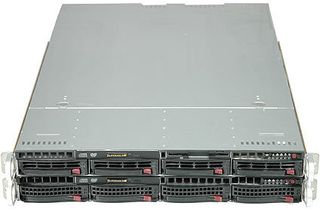Intel Xeon and AMD Opteron Battle Head to Head
Summary And Conclusion

The Woodcrest platform performed very well, exceeding our initial expectations. It is the fastest in all of the tests and completely dominates our benchmarks. The new Xeon 5100 series helps Intel to get back on track, providing class-leading server/workstation processors. The now older 5000-series (Dempsey) Xeon, based on the Netburst architecture, is often last in the competition and merely serves as a point of reference in our tests.
Intel has retaken the throne from AMD in the server/workstation sector and sent AMD back to the drawing board. Next month Intel will release the quad core Clovertown CPU with 2 combined Woodcrest cores. AMD is ready for this threat with the introduction of their X4 Opteron, which is reported to have a L3 cache. Servers will benefit more from these quad core processors than desktop users due to the limited deployment of multithreaded-capable applications in the desktop sector in comparison to the server sector.
In mid-2007 AMD is expected to answer Intel's new threat with a line of faster Opterons utilizing the new Socket F, as well as support for DDR2 memory. Whether or not this will be enough to regain the performance lead has yet to be seen, but with no major architectural changes, it is expected that Intel will still retain the overall better performance per watt status.
In all, both platforms perform quite well, but the nod goes to the Xeon 5100 series for its superior performance and greater efficiency.
Author's Opinion
The requirements that those shopping for a server consider most are cost, performance and power consumption. From the benchmarks it is quite evident that the Intel Xeon 5160 is superior in the latter two categories compared to the other top-of-the-line dual core processors. Taking into consideration that the Xeon 5080, 5160 and Opteron 285 all retail for about $870, it would seem that the Xeon 5160 is the logical choice.
Intel's decision to introduce the Woodcrest Xeon 5100 series only one month after the introduction of the Dempsey Xeon 5000 series was unusual. There could be many explanations for this. The production of the Dempsey could have fallen behind schedule; with the time and budget spent on the project it may have been deemed to be too costly to can the project, and so they went ahead with its release. On the other hand, it could be that the development and production of the Woodcrest was ahead of schedule, and given its significantly better performance and power specifications, Intel decided to rush it to the market ahead of AMD's Socket F to regain the performance lead. Although this is all speculation, we are grateful nonetheless that Intel got Woodcrest to the market sooner rather than later.
Join our discussion on this topic
Stay on the Cutting Edge
Join the experts who read Tom's Hardware for the inside track on enthusiast PC tech news — and have for over 25 years. We'll send breaking news and in-depth reviews of CPUs, GPUs, AI, maker hardware and more straight to your inbox.
Most Popular

